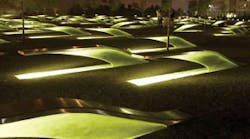On Sept. 11, 2001, 184 people died when terrorists hijacked American Airlines Flight 77 and crashed it into the western face of the Pentagon in Arlington, Va. A memorial park honoring victims of this attack opened at the Pentagon last September, exactly seven years after the tragedy occurred. The first official memorial to be constructed at one of the three 9/11 crash sites, the 1.95-acre park incorporates a unique lighting design to help remember those who perished that day.
Conceptualized by architects Keith Kaseman and Julie Beckman, the memorial comprises 184 cantilevered units — each engraved with a victim's name — in bench-like forms of cast stainless steel, extending from one end of low-scale rectangles of illuminated water. Integral to the project is uniform white light that shines into and across the individual bodies of water in each reflecting pool.
“This is the primary light source for the park,” explains Chris Hartzler, senior project manager for Dallas-headquartered Balfour Beatty Construction, the project's general contractor. “A key challenge was to mount the light horizontally, underground, have it reflect through water, and still emit enough light so that visitors could safely navigate their way through the park at night.”
Because the memorial is open to visitors 24/7/365, Hartzler says much deliberation went into selecting a lamp that not only offered sufficient illumination, but also featured a lengthy operating life. After considering alternate sources, such as an LED fixture, a 55W electrodeless induction lamp with an expected 100,000-hr life was chosen.
“The concern with using an LED fixture was that each individual diode would burn out over time as opposed to the lamp with which we went,” Hartzler says. “When the induction lamp burns out, it's immediately replaced. This way, you don't get varying light levels between each unit, which maintains the memorial's design integrity.”
Wood-Ridge, N.J.-based Starfire Lighting, a designer and manufacturer of custom and industrially produced contemporary indoor and outdoor lighting fixtures, took the architects' lighting concept and brought it to fruition, designing and building a custom, compact sealed light box to house the induction lamp the company had chosen.
According to Hartzler, heat generated by the enclosed 120V luminaire caused some concern. To address this potential problem, Balfour Beatty and Starfire devised a clever solution.
“The water from each unit is being used to help cool the fixtures,” says Hartzler. “There is a directional flow over the top of the light box and onto the back plate. You can't see the water hitting the back plate of the fixture, but that's what's cooling the lights.”
Another issue that had to be resolved was the potential for the memorial's 184 induction lamps to create sufficient electromagnetic interference (EMI) and radio frequency interference (RFI) to inhibit the sensitive, high-tech equipment inside the Pentagon. Thus, each fixture includes RFI and EMI shielding.
In the event a luminaire needs to be replaced, Hartzler says this can be done easily by a member of the park's maintenance team without disruption to any of the other units.
“Every light is circuited and runs on a time clock,” he notes. “In my opinion, the best time to view the park is at dusk when all the lights come on. The place is literally transformed.”
Perhaps the most challenging aspect of the Pentagon Memorial Project, according to Hartzler, was something no one could control: the weather. However, despite constant exposure to the elements and extreme temperatures, the work crew finished almost two weeks ahead of schedule.
“The entire workforce did an amazing job,” remarks Hartzler. “The success of this project is a real testament to everyone who had a hand in it — including the Pentagon Memorial Fund, family members, designers, and craftsman. My hope is that many people will take time to visit the park and reflect on the events that happened there that day.”



